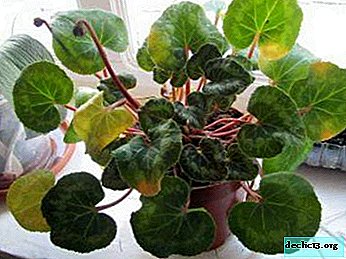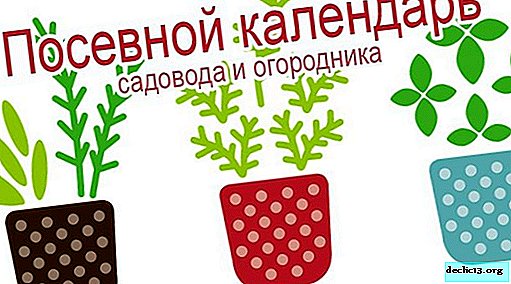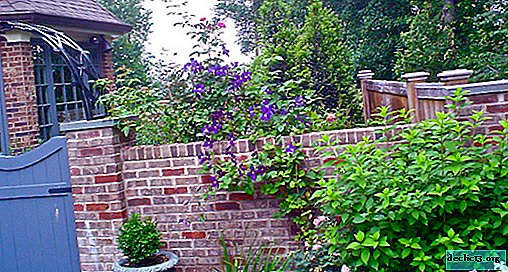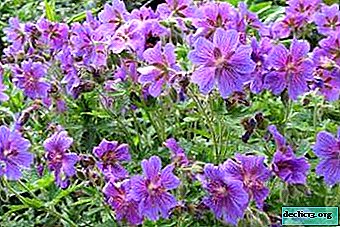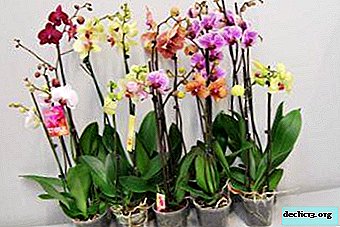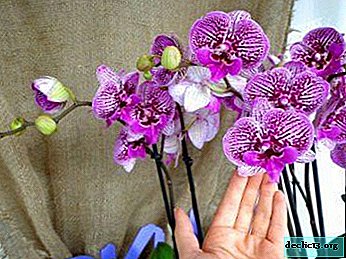"Cuckoo's tail", or cylindrical sansevieria - description, photo, nuances of home care

Sansevierium plants are often found in public institutions and offices. They gained popularity due to their unpretentiousness in care, as well as an unusual and beautiful form. In this article we will talk about cylindrical sansevieria. You can find out what this genus of sansevieria is, what its species are, how it blooms, how to care for it, and what pests and diseases can threaten it.
Botanical description of the cylinder
Cylindrical sansevieria, or cylindrical (Latin Sansevieria cylindrica) - a perennial stemless herbaceous plant, family Asparagaceae (Asparagaceae), a species of the genus Sansevieria (Sansevieria). The plant is also called Cylinder. Sansevieria belongs to succulents, as a plant is able to store water in its tissues.
There are 69 species in the genus, of which about ten are suitable for indoor planting. Such varieties as Laurenti, Belaya Sanseviera, Futura, Robusta and Tsilindrika are popular. We have heard such names as: mother-in-law's tongue, cuckoo's tail or the tongue of the devil. Outside of our country: snake plant, leopard lily, snake skin, African hemp.
This hardy plant has earned the title of indestructible. The genealogy of Sansevieria is cylindrical rooted in the tropical forests of South Africa (Angola, Zambia and Zimbabwe). They can also be found wild in Indonesia and India, North America. In the 14th century, the plant was adapted for indoor cultivation.
The cylinder is different in that dense leaves grow directly from the ground, from the roots, in the form of twisted tubes (“cylinders”) of dark green shades, with a deepened longitudinal hollow and yellow strokes on the surface. The leaves are arranged vertically, deviate slightly, when planting with a rosette, resemble tentacles. The edges of the foliage are whole, and the tips are pointed and often the dangerous ends are closed so as not to get hurt. Every year, two or three new shoots are added to the bush.
There are several varieties of Cylinders: Spaghetti, Mikado, Spike, and Twister. For example, the leaves of Twister are very flexible and they are often braided in a pigtail.
Photo
In the photo below, you can see how the sansevier of the cylinder looks like, what its leaves are:





And this is a photo of how a cylinder blooms:



Home Care
- Temperature. The plant feels comfortable in the summer at a temperature of 15-25 ° C and in winter, at rest 10-15 ° C. When the temperature drops below five degrees, the plant is prone to death.
- Watering. Rare: in the summer no more than once a week, in the winter 1-2 a month. Spraying is not required, but you need to wipe the leaves from dust. In order not to forget when it is time for watering, you can purchase special humidity indicators in the flower shop.
- Shine. Illumination does not play a role, the sun and shadow tolerate the sanseviera, but light must fall on it, at least from artificial sources. Windows are suitable for any, except the north.
- Priming. A soil with a slightly acidic or neutral reaction is suitable for the cylinder. Sand, turf and sheet soil, in a proportion of 1/2/1 parts of each material.
- Pruning. To get a stalk, you need to cut a leaf blade 5-10 centimeters long. The cut point must be treated with crushed activated carbon.
- Top dressing. In the summer, starting in May, it is recommended to fertilize the devil's tongue with minerals for cacti and succulents. Monthly, until October.
- Pot. Shallow and wide, since the root system of the plant is quite compact. Mostly ceramic.
- Transfer. If the roots of the plant appeared from a hole in the bottom of the pot, this is a sign that he was cramped and it was time to replace the pot. The best time to transplant Sansevieria is spring.
First, the bottom of the pot is covered with a layer of pebbles or any other drainage material. Then the soil is filled up and the prepared cuttings or the separated rhizomes of the bush are immersed.
A young plant is recommended to be replanted annually, adults after two to three years.
Reference! After transplanting, do not water the soil for a week, and do not feed the plant during the first month. - Rooting. usually happens very easily. Wintering Rest period from October to February.
- Breeding. In room conditions, sansevieria is propagated by vegetative methods. Cylindrical propagation occurs when the roots of the bush are divided and grafts are transplanted into a mixture of peat and sand, about 10 centimeters long, at a temperature of 20 ° C to 25 ° C.
- Bloom. During the flowering period, the plant produces a peduncle, which can reach 1.5 meters in length. On the peduncle, flowers are evenly arranged, white with pinkish splashes. The flower stalk is cut off when the flower fades.
Diseases and pests of sansevier
The plant is quite unpretentious, but some diseases can occur:
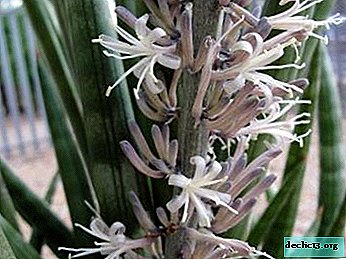 Dark, brown spots on leaflets due to low temperature and excessive watering. To fix this, you need to rearrange the plant in heat and less often to water.
Dark, brown spots on leaflets due to low temperature and excessive watering. To fix this, you need to rearrange the plant in heat and less often to water.- Yellowing leaves indicates a lack of light or a too small pot size. Also, from a lack of light and watering, leaves can become lethargic.
- The drying tips of the plant - from excess water and low temperature.
- The leaves become soft at the base - perhaps the water got into the center of the outlet and a fungal disease started.
- If red spots with a yellow fringing jumped on the leaves - a fungal disease.
- It is extremely rare for pests to plant on the plant - thrips and spider mites.
Similar plants
- Some types of aloe.
- Gasteria.
- Agave.
- Haworthia.
Sansevieria leaves absorb formaldehyde, which means they also serve as an air purifier. Like aloe, cut pieces of leaves can be applied to wounds, burns.
Important! The plant should not be accessible to children and animals, since eating leaves can lead to poisoning.If you adhere to the correct regular care, then the appearance of cylindrical sansevieria will delight the eye with dense, shiny leaves with variegated coloring, decorating any interior.

 Dark, brown spots on leaflets due to low temperature and excessive watering. To fix this, you need to rearrange the plant in heat and less often to water.
Dark, brown spots on leaflets due to low temperature and excessive watering. To fix this, you need to rearrange the plant in heat and less often to water.


